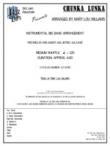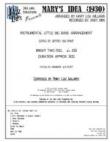ARIES MOOD (PORTRAIT OF BEN WEBSTER) [DOWNLOAD]
Recorded by the Dutch Jazz Orchestra
Arranged by Mary Lou Williams, Prepared by Dylan Canterbury, Rob DuBoff, and Jeffrey Sultanof

Cat #: JLP-8783-DL
$55.00This product is available for immediate download after purchase.
Questions?
Please call +1-518-587-1102 or email us.
Edition: Jazz Big Band Arrangement
Description: Swing/Ballad - Medium Difficult
Publisher: Jazz Lines Publications
By the time Mary Lou Williams composed 'Aries Mood,' she had all but completely retired from the public spotlight, instead working behind the scenes as one of jazz's first great educators. On the few occasions that she did offer up her writing skills during this time period, she clearly had not lost any of her talents despite being somewhat out of regular practice.
Written in 1968 for the Danish National Radio Jazz Band as a tribute to the great tenor saxophonist (and one-time Ellingtonian) Ben Webster, 'Aries Mood' was not recorded upon its initial composition. In fact, it took roughly 60 years before the piece was finally documented by the Dutch Jazz Orchestra on their 2005 recording 'The Lady Who Swings The Band: Rediscovered Music of Mary Lou Williams.'
The piece begins at a brisk tempo featuring typical Williams complexity: a knotty melody line in the saxophones, dissonant brass blasts, and an overall surprising sense of urgency. Without even a hint, however, the piece abruptly slows down to a slightly-less-than-half-time tempo at measure 18. It is at this point that we see another side of the portrait of Ben Webster as things enter with aggressive, even raunchy low brass honks and a tricky yet sensual alto sax solo (likely meant to conjure up fellow Ellingtonian Johnny Hodges) that begins at measure 36. During this portion of the chart, the pianist is advised to add sparse fills in the gaps in between the ensemble riffs.
The alto solo is handed over to an optional flute solo beginning at measure 56, which serves as the chart's focal point until an abrupt shift back to the original tempo at measure 76. The Dutch Jazz Orchestra substituted a trumpet solo in place of the flute solo. Beginning at measure 92, the tenor saxophonist gets a solo moment, eventually being joined by the flute once more at measure 100. The duel continues until the final three bars of the piece, where the rest of the band comes in with some short, dissonant honks that bring the piece to a sudden, yet appropriate, conclusion.
This arrangement is written for standard big band instrumentation. It is not a transcription - everything has been engraved from Williams's original score and set of parts. We hope you enjoy this arrangement as much as we enjoyed preparing it for you!
2 Alto Saxophones (Alto 1 Optional Flute Double)
2 Tenor Saxophones
Baritone Saxophone
4 Trumpets
3 Trombones
Piano
Bass
Drums
Trombone 1: A4










